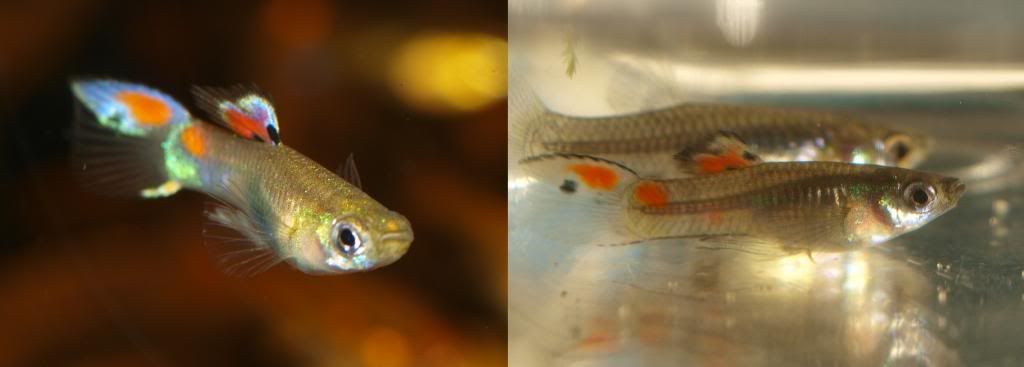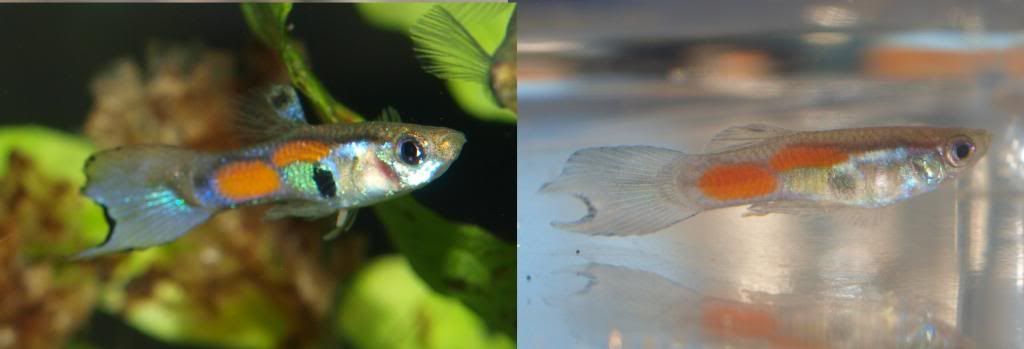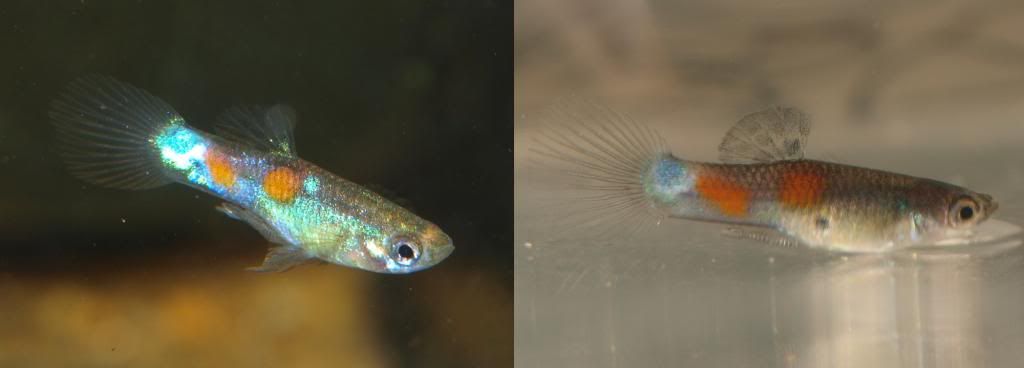Here is a quick update of my fathers tank, 30+ years running (more about this tank under Archived Posts).
The bottom photo is from last Christmas 2012 and the upper photo is from today, 2013.
As you can see black beard algae has taken over the tank during the year. I do like it for some reason, but it will have to go.
Friday 20 December 2013
Wednesday 11 December 2013
Updated photos, Wild Brazilian Guppies, Poecilia reticulata
The new wild caught
Brazilian guppies have now been separated into individual tanks to make sure
that all of the founders get a chance to reproduce.
The photos on the left were taken when the males had settled down a bit, they are quite different then the stress colouration shown on the right.
Even now I do not find that the photographs are particularly representative as these fish seems to display different colours depending on moods, setting and lighting.




All of the females have dropped fry which is great, and the fish seem to have settled in well.
More to come regarding these,
The photos on the left were taken when the males had settled down a bit, they are quite different then the stress colouration shown on the right.
Even now I do not find that the photographs are particularly representative as these fish seems to display different colours depending on moods, setting and lighting.




All of the females have dropped fry which is great, and the fish seem to have settled in well.
More to come regarding these,
Labels:
brazil,
brazilian,
breeding,
caught,
founders,
guppies,
guppy,
ireland,
male,
photo,
photos,
pictures,
poecilia,
reticulata,
south america,
wild,
wild caught
Thursday 5 December 2013
Corydoras concolor, Male
Got a lucky snap last night of the alpha male feeding from the surface.
This individual has been the strongest and fastest grower since they were about 3cm in length, he is now the boss of the tank and a stunning fish imo.
Andreas
Sunday 1 December 2013
Oak Leaves
 |
| Todays crop: a box of dryed oak leaves |
Dead leaves are beneficial to the home aquaria in many ways. I'm using oak leaves myself and as this is the season to be picking them I thought I would write a quick post about them.
Why Leaves
The benefit of using leaves in the aquaria are many and there is plenty information available on this subject, I will shorty highlight some of them below.Looks
Many of our aquarium fishes come from habitats littered with leaves. Heiko Bleher himself mentioned how he knew that he would find Apistogramma species in a leaf litter habitat (MaxiZoo talk, Dublin 2013). Oak leaves are a great way for any aquarist that wants to try to replicate such a habitat and it does usually look great.
Biotope/breeding
Tannins released from the leaves helps lowering the pH and stain the water to a tea-color. This further replicates the habitats of many blackwater species. Replicating the natural habitat in this way will significantly increase any breeding attempts.
Hiding
Leaf litter provides an abundance
of hiding spots for fry and adult fish alike which adds to the general wellbeing
of the fish. In a breeding tank leaves can be the difference between a good
survival rate of fry or an unsuccessful attempt.
Food source
The leaves are also
beneficial to the growth of fry as they provide an environment for
microorganisms on which many fry feed. I often use oak leaves in my rearing tanks and
lately a batch of Hypancistrus debilittera were grazing eagerly on the leaves,
the batch grew very well and I contribute part of that to the constant availability
of food, deriving from the leaves.Preparation
I have only used oak leaves and can only comment on them.Collection
Pick clearly dead/dry leaves of a species you know is aquarium safe. Pick only leaves that have already fallen to the ground. Avoid leaves from a polluted area, rotting, exhibit fungi growth or anything else you are not sure about.
Storage
Store the leaves in a dry area, I use an open card box for this purpose. Do not store them in plastic bags or sealed container until you are certain that they are completely dried out. Pick out any “bad” leaves prior to use. I usually dry the leaves for at least a month before use.
Use
Adding leavesAdd the leaves gradually, you will get familiar with how much leaves you need and how they affect the color of the water. The leaves will decompose over time, you can either leave them as they are or if you are afraid of leaf matter clogging the filter/spoiling the looks; siphon the smaller pieces out while performing a water change. Just make sure that you don’t siphon out your fry, in a set up with leaf litters fry can often go unnoticed from view.
Fish species
The effect the leaves have on the water makes them suitable for blackwater species. Personally I use oak leaves in tanks with species of Ancistrus, Corydoras, Hara, Peckoltia, Pelvicachromis and various tetras. Make however sure of what conditions the particular species you keep needs before planning the tank.
Labels:
aquarium,
biotope,
breeding,
fish,
leaf,
leaves,
litter,
natural,
oak,
preparation,
south america,
spawning,
tank
Subscribe to:
Posts (Atom)


